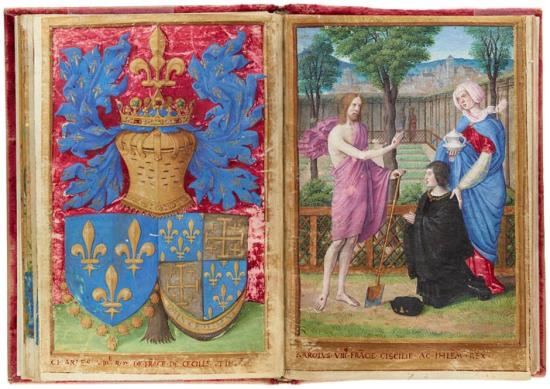
Bifolio inserted into a Book of Hours
Illuminated by Jean Poyer
Purchased by Pierpont Morgan, 1907
King Charles VIII in a New Look
The heraldry — which calls Charles VIII king of France, Sicily, and Jerusalem — dates this image of the kneeling monarch to the short period in which he ruled (at least titularly) those two far-flung realms. Charles wears a new garment, the sayon, a man's outer coat, often of luxurious cloth, with a fitted waist and a many-gored skirt. Its huge sleeves are typical of the 1490s. He is shod in new pantoffles, round-toed slippers (often with open backs). Before him lies the new carmignolle, a man's hat with a low crown and a divided brim held up by laces (of which the gold aglets are visible).
Twilight of the Middle Ages
This was a period of transition in northern Europe—the Middle Ages were not yet over, and the Renaissance had not yet begun. Both King Charles VIII and Louis XII invaded Italy, and these military campaigns exposed France to Italian art, culture, and fashion. At the same time, the Late Gothic style still dominated the arts—and clothing—of northern Europe. Fashions of this period reflect these conflicts.
In the 1480s, the look for men changed abruptly. Padded shoulders and the V-shaped silhouette disappeared. Long loose open gowns came into style and, by the 1490s, these gowns became especially voluminous and bulky. Round-toed shoes replaced the pointy pouleines. New, however, and probably reflecting Italian influence, were the man's outer coat called a sayon, the man's hat called a carmignolle, and doublets with slit sleeves through which the linen of the shirt protruded.
Women's gowns of this period also became fuller, and bombard sleeves were revived. The neck got square. The turret disappeared, while its frontlet remained, now attached to a new small-crowned coif.
